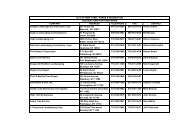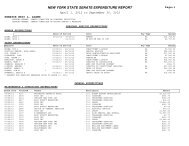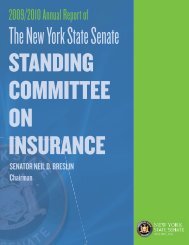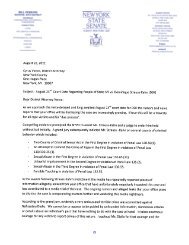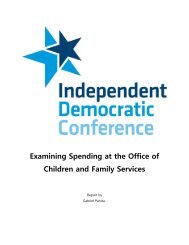Crime Committee Report e.indd - New York State Senate
Crime Committee Report e.indd - New York State Senate
Crime Committee Report e.indd - New York State Senate
Create successful ePaper yourself
Turn your PDF publications into a flip-book with our unique Google optimized e-Paper software.
Chapter 337 of the Laws of 2009<br />
S.5645 HASSELL-THOMPSON / A 8521 Aubry<br />
Erroneous Sentences<br />
Signed into law by Governor Paterson, this legislation requires the Department of Correctional<br />
Services (“DOCS”) to notify the district attorney, the inmate’s defense counsel and the<br />
sentencing court, whenever it is of the opinion that the sentence was illegal. Moreover, this bill<br />
authorizes the district attorney, at the court’s direction to ensure the inmate is promptly produced<br />
in court to participate in the issue of re-sentencing. Prior to this law the <strong>New</strong> <strong>York</strong> Judiciary<br />
was in the middle of what was reported as the “post release supervision” controversy; that<br />
is, a situation where hundreds of defendants were not properly sentenced by the court. This<br />
new law provides a stated process, requiring the prison system to contact all parties; authorizing<br />
the court or district attorney to produce the defendant in court; notifying the defense attorney<br />
of the issues so that representation can be prepared; and constructs an avenue for the court to<br />
correct illegal sentences in an expeditious manner.<br />
Constitutional Amendment<br />
S.4124 HASSELL-THOMPSON, DIAZ, MONSERRATE, VOLKER / A 5598 Aubry<br />
Passed to amend the <strong>State</strong> Constitution by referendum of the People of the <strong>State</strong> of <strong>New</strong><br />
<strong>York</strong>, this joint <strong>Senate</strong>-Assembly resolution, passed in two distinct legislative sessions, allows a<br />
law to be passed to permit prisoners to voluntarily perform work for nonprofit organizations.<br />
Non-profit organizations means an organization operated exclusively for religious, charitable,<br />
or educational purposes, no part of the net earnings of which inures to the benefit of any<br />
private shareholder or individual. Prior to this law section 24 of article 3 of the <strong>New</strong> <strong>York</strong> <strong>State</strong><br />
Constitution prohibited the “farming out, contracting, giving away or selling of convict labor.”<br />
However, many localities had requested that an exemption be made for nonprofit organizations<br />
who are often underfunded and do not have the resources to adequately maintain their<br />
property. The law did permit inmates to work in state and public institutions and many of the<br />
nonprofit organizations engaged in public works and charities. This constitutional amendment<br />
was initiated by Senator Dale Volker during the first required session vote and taken to the finish<br />
line by Senator Ruth Hassell-Thompson, a republican and democratic member respectively.<br />
This amendment appeared on the ballots during the 2009 statewide elections in <strong>New</strong> <strong>York</strong><br />
<strong>State</strong> and was authorized by a favorable vote of the electorate.<br />
Chapter 57 of the Laws of 2010<br />
S.6725 SCHNEIDERMAN, ADAMS, BRESLIN, DILAN, DUANE, ESPADA, HASSELL-THOMPSON,<br />
HUNTLEY, KRUEGER, MONTGOMERY, ONORATO, OPPENHEIMER, PARKER, PERKINS,<br />
SAVINO, SERRANO, SQUADRON, STAVISKY, STEWART-COUSINS, THOMPSON<br />
Prison Gerrymandering<br />
The purpose of this bill is to count people in prison at their addresses prior to incarceration<br />
for the purposes of redistricting.<br />
Currently, the United <strong>State</strong>s Bureau of the Census includes everyone housed in federal, state,<br />
and local correctional facilities in its count of the general population of the Census block that<br />
contains the facility. The state’s current reliance on the Census Bureau’s flawed prison counts<br />
when drawing legislative districts, violates federal law in two ways: it dilutes minority voting<br />
strength in violation of Section 2 of the Voting Rights Act of 1965; and it violates the one person,<br />
one vote principle of the Equal protection Clause, which requires voting districts to have<br />
equal numbers of residents (because people in prison are not residents of the districts where<br />
they are incarcerated and counted).<br />
50<br />
<strong>New</strong> <strong>York</strong> <strong>State</strong> <strong>Senate</strong>



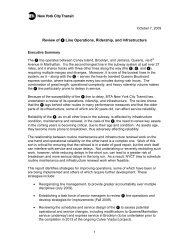


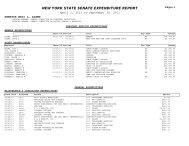
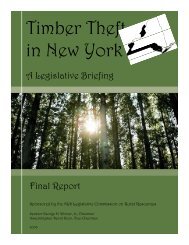

![[PDF] Proposed MTA Capital Program - New York State Senate](https://img.yumpu.com/24854139/1/190x245/pdf-proposed-mta-capital-program-new-york-state-senate.jpg?quality=85)

